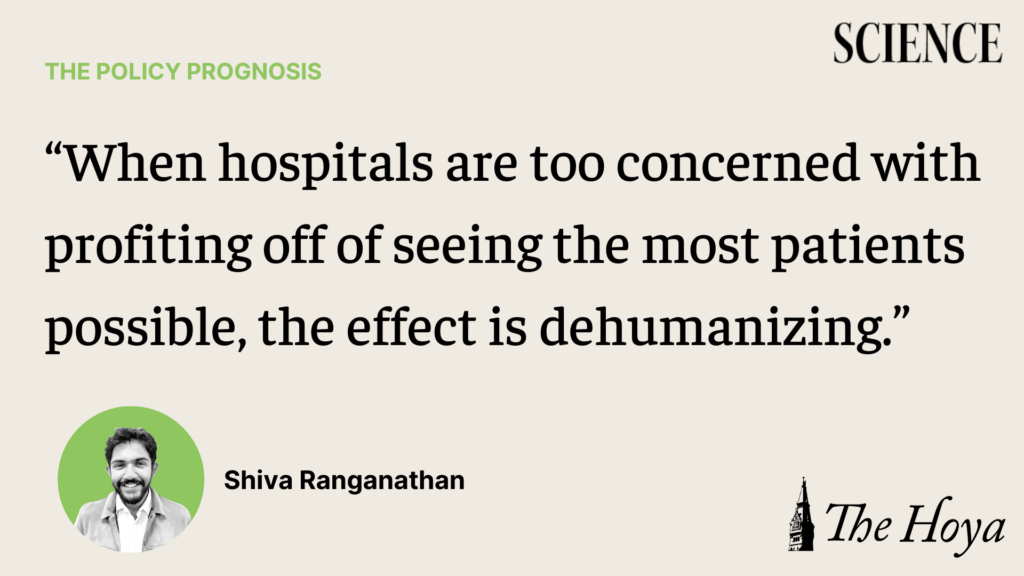The term “nonprofit” has lost its meaning as money flows into health systems with little to no increase in charitable care.
Nonprofit health systems are hospitals that use their proceeds toward community improvement and are therefore excluded from paying most taxes. Yet about 86% of nonprofits end up providing significantly less charitable care than their extra revenue allows for. In fact, nonprofit hospitals currently have mean operating profits of $58.61 million, while for-profit hospitals have mean operating profits of $43.38 million. How can this discrepancy between their charitable mission and their financial profits be possible?
While the idea of nonprofit hospitals is benevolent on paper, in practice, the system fails providers, who have to oblige the demands of the fee-for-service model, which yields a fixed payment for the number of services used, and patients, who are offered subpar care compared to for-profit counterparts with better technology. Furthermore, nonprofit hospitals are a heavy cost for the overall health industry, with subsidies in the form of tax exemptions amounting to billions of dollars each year.
The primary issue with nonprofit hospitals is neither their failure to maximize charitable care nor that they make more money than for-profit systems. However, when the title “nonprofit” allows health systems to take advantage of government subsidies that are designed to expand access to affordable health care without following through on the promise to give back through better technology and health outcomes, taxpayer dollars fail to provide health services to those who need them most.
Nonprofit hospitals receive government subsidies based on the number of services they provide to patients with little or no insurance. To maintain nonprofit status, the government evaluates health systems based on Medicare and Medicaid payments, which are currently based on a fee-for-service system. This practice undermines the concept of value-based care, where payment is based on patient outcomes instead of the number of services provided, incentivizing providers to adopt a profit-centered mentality rather than focusing on better patient outcomes. When hospitals are too concerned with profiting off of seeing the most patients possible, the effect is dehumanizing.
Additionally, because government financing of nonprofit health systems is based on the number of patient visits or medical technologies used, hospitals will often reduce their staff to lower their expenses and take on more patients to increase the revenue made from government payments. In Jan. 2023, the Community Health Network, a nonprofit hospital system that runs primary, specialty and emergency care institutions nationwide, stated that they were cutting down their staff size despite making profits of $12.21 billion. Since there are vague standards for what counts as charitable care, it is difficult for the government to evaluate the extent of a hospital’s charitable care contribution, so many nonprofit systems like the Community Health Network are able to avoid criticism.
While some nonprofit hospitals may claim that their charitable care justifies their tax exemption, some employ another profit-maximizing technique: underreporting the value of insurance-covered charges. Thus, it might appear that the hospital system is paying a large portion of its revenue toward funding patient services when, in reality, private insurance companies are covering these expenses.
Over a decade ago, the government raised standards of subsidization for nonprofit hospitals, but considering that many nonprofit health systems still underperform in providing to communities, it is time to reevaluate the minimum threshold for charitable care. The Patient Protection and Affordable Care Act of 2010 mandated that hospitals consider community needs and adequately report their positive impact on the people they serve. It’s time for health policymakers to return to the same conversation and hold such systems accountable to the charitable benefit they claim to provide as we see health costs skyrocketing higher than ever before.
If nonprofit hospitals dedicated government subsidies to improving technologies, such as recent AI work that employs outdated and racially biased algorithms, patients would see better health outcomes and quality of care. Furthermore, public health experts recommend raising the bar on the definition of community benefit, which would require nonprofit hospitals to have a more visible impact on society and provide an easier way for policymakers to evaluate them. In addition, integrating nonprofit hospitals in public health agencies, which set a care requirement to give hospitals their credentials and give medical and ethical training to member hospitals under their umbrella, could limit excessive debt collection from patients. Nonprofit systems like the University of Virginia showcase this problem — they sue an average of 6,000 patients per year for not paying enough of their charges.
Nonprofits must abandon the for-profit mindset and abuse of government subsidies and increase quality of care instead of cramming a large number of patients into a few providers’ schedules.









